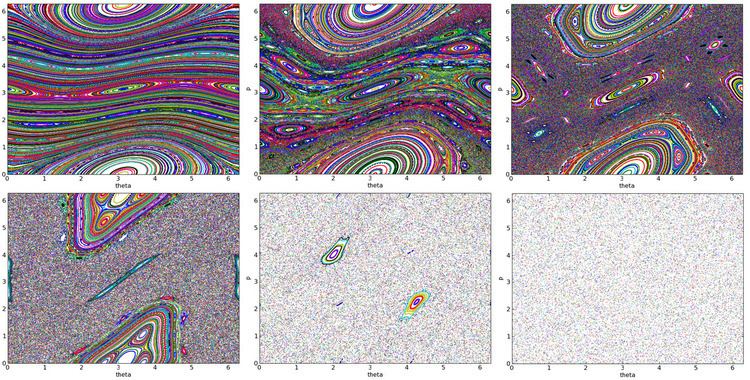 | ||
The kicked rotator, also spelled as kicked rotor, is a prototype model for chaos and quantum chaos studies. It describes a particle that is constrained to move on a ring (equivalently: a rotating stick). The particle is kicked periodically by an homogeneous field (equivalently: the gravitation is switched on periodically in short pulses). The model is described by the Hamiltonian
Contents
- Main properties classical
- Main properties quantum
- The effect of noise and dissipation
- Experiments
- References
Where
With the caveat that
Main properties (classical)
In the classical analysis, if the kicks are strong enough,
The averaged diffusion of the momentum-squared is a useful parameter in characterizing the delocalization of nearby trajectories. The inductive result of the standard map yields the following equation for momentum
The diffusion can then be calculated by squaring the difference in momentum after the
In the chaotic domain, the momenta at different time points may be anywhere from entirely uncorrelated to highly correlated. If they are assumed uncorrelated due to the quasi-random behaviour, the sum involving the cross-terms
That is, the momentum diffusion in the chaotic domain has somewhere between a linear and a quadratic dependence on the number of kicks. An exact expression for
Main properties (quantum)
In the quantum analysis, the Hamiltonian must first be rewritten in operator form, using the substitution
The wavefunction can then be solved for using Schrödinger's equation
where
The wavefunction at the
It can be shown that the coefficients are given recursively by
Where
Given some set of initial conditions, it is relatively straightforward to numerically solve the recursive equation above for all time, and substitute the calculated coefficients back into the momentum eigenstate decomposition to find the total wavefunction. Squaring this gives the time evolution of the probability distribution, thus providing a complete quantum mechanical description.
Another way to calculate the time evolution is to iteratively apply the unitary operator
It has been discovered that the classical diffusion is suppressed, and later it has been understood that this is a manifestation of a quantum dynamical localization effect that parallels Anderson localization. There is a general argument that leads to the following estimate for the breaktime of the diffusive behavior
Where
The effect of noise and dissipation
If noise is added to the system, the dynamical localization is destroyed, and diffusion is induced. This is somewhat similar to hopping conductance. The proper analysis requires to figure out how the dynamical correlations that are responsible for the localization effect are diminished.
Recall that the diffusion coefficient is
In the quantum case, without the noise, the area under
Also the problem of quantum kicked rotator with dissipation (due to coupling to a thermal bath) has been considered. There is an issue here how to introduce an interaction that respects the angle periodicity of the position
Experiments
Experimental realizations of the quantum kicked rotator have been achieved by the Raizen group, and by the Auckland group, and have encouraged a renewed interest in the theoretical analysis. In this kind of experiment, a sample of cold atoms provided by a Magneto-optical trap interacts with a pulsed standing wave of light. The light being detuned with respect to the atomic transitions, atoms undergo a space-periodic conservative force. Hence, the angular dependence is replaced by a dependence on position in the experimental approach. Sub-milliKelvin cooling is necessary to obtain quantum effects: because of the Heisenberg uncertainty principle, the de Broglie wavelength, i.e. the atomic wavelength, can become comparable to the light wavelength. For further information, see. Thanks to this technique, several phenomena have been investigated, including the noticeable:
